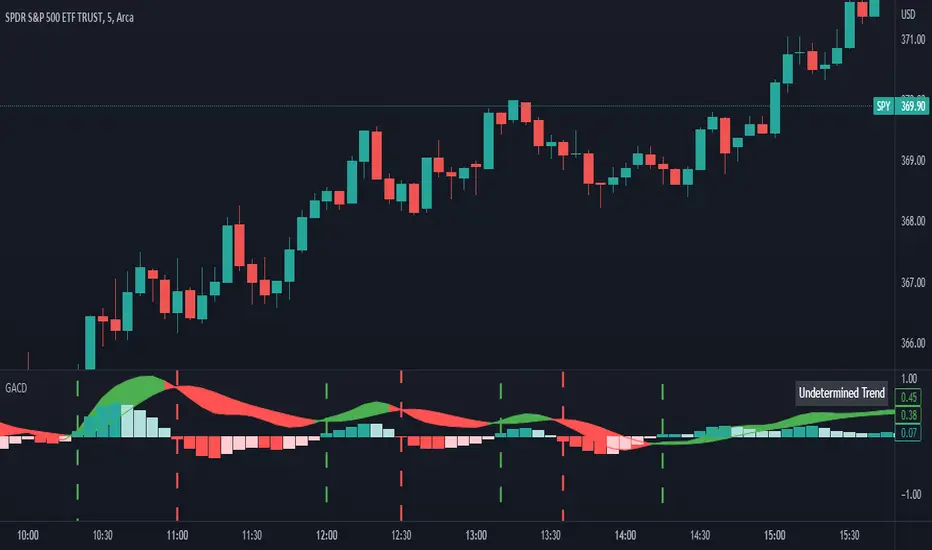OPEN-SOURCE SCRIPT
Gaussian Average Convergence Divergence

What exactly is the Ehlers Gaussian filter?
This filter is useful for smoothing. It rejects higher frequencies (fast movements) more effectively than an EMA and has less lag. John F. Ehlers published it in "Rocket Science For Traders." Dr. René Koch was the first to implement it in Wealth-Lab.
The transfer response of a Gaussian filter is described by the well-known Gaussian bell-shaped curve. Only the upper half of the curve describes the filter in the case of low-pass filters. The use of gaussian filters is a step toward achieving the dual goals of lowering lag and lowering the lag of high-frequency components relative to lower-frequency components.
From Ehlers Book: "The first objective of using smoothers is to eliminate or reduce the undesired high-frequency components in the price data. Therefore these smoothers are called low-pass filters, and they all work by some form of averaging. Butterworth low-pass filters can do this job, but nothing comes for free. A higher degree of filtering is necessarily accompanied by a larger amount of lag. We have come to see that is a fact of life."
References John F. Ehlers: "Rocket Science For Traders, Digital Signal Processing Applications", Chapter 15: "Infinite Impulse Response Filters"
This filter is useful for smoothing. It rejects higher frequencies (fast movements) more effectively than an EMA and has less lag. John F. Ehlers published it in "Rocket Science For Traders." Dr. René Koch was the first to implement it in Wealth-Lab.
The transfer response of a Gaussian filter is described by the well-known Gaussian bell-shaped curve. Only the upper half of the curve describes the filter in the case of low-pass filters. The use of gaussian filters is a step toward achieving the dual goals of lowering lag and lowering the lag of high-frequency components relative to lower-frequency components.
From Ehlers Book: "The first objective of using smoothers is to eliminate or reduce the undesired high-frequency components in the price data. Therefore these smoothers are called low-pass filters, and they all work by some form of averaging. Butterworth low-pass filters can do this job, but nothing comes for free. A higher degree of filtering is necessarily accompanied by a larger amount of lag. We have come to see that is a fact of life."
References John F. Ehlers: "Rocket Science For Traders, Digital Signal Processing Applications", Chapter 15: "Infinite Impulse Response Filters"
Nota Keluaran
- Made some changes that optimized the code- Added different customization options
- Chart Updated
Nota Keluaran
- Fixed bug with colors- Added custom band settings
Nota Keluaran
- Updated more customization options for vertical lineNota Keluaran
- Updated bug with band fillSkrip sumber terbuka
Dalam semangat TradingView sebenar, pencipta skrip ini telah menjadikannya sumber terbuka, jadi pedagang boleh menilai dan mengesahkan kefungsiannya. Terima kasih kepada penulis! Walaupuan anda boleh menggunakan secara percuma, ingat bahawa penerbitan semula kod ini tertakluk kepada Peraturan Dalaman.
Penafian
Maklumat dan penerbitan adalah tidak bertujuan, dan tidak membentuk, nasihat atau cadangan kewangan, pelaburan, dagangan atau jenis lain yang diberikan atau disahkan oleh TradingView. Baca lebih dalam Terma Penggunaan.
Skrip sumber terbuka
Dalam semangat TradingView sebenar, pencipta skrip ini telah menjadikannya sumber terbuka, jadi pedagang boleh menilai dan mengesahkan kefungsiannya. Terima kasih kepada penulis! Walaupuan anda boleh menggunakan secara percuma, ingat bahawa penerbitan semula kod ini tertakluk kepada Peraturan Dalaman.
Penafian
Maklumat dan penerbitan adalah tidak bertujuan, dan tidak membentuk, nasihat atau cadangan kewangan, pelaburan, dagangan atau jenis lain yang diberikan atau disahkan oleh TradingView. Baca lebih dalam Terma Penggunaan.